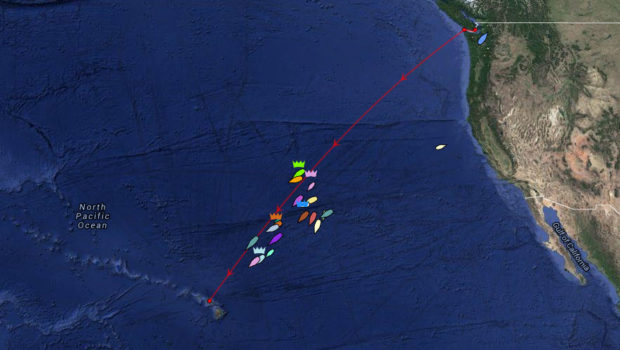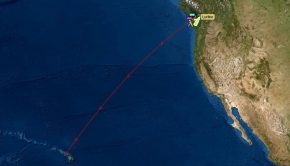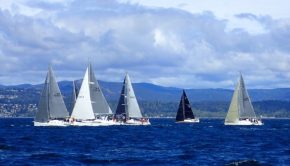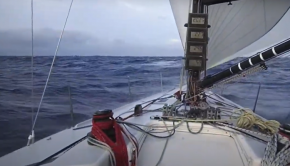Vic-Maui: The Goldilocks Gybe
Published on July 19th, 2016
The 2308 nm Victoria to Maui International Yacht Race is hosted by the Royal Vancouver Yacht Club and the Lahaina Yacht Club. The fleet of 22 entrants had four staggered starts on July 9, 10, 11, and 12. Here is a report from the race office on July 19…
Everyone is Going Fast
The Leaderboard looks funny as we re-started Turnagain and Forty in a new two-boat match race for supremacy in Cruising Class. We are not sure how to handicap tuna caught and lamb roast enjoyed, but we will try. Anyway, the different distance and start-time will makes it look like one of these two are leading the race for a while. To make the Leaderboard more accurate, make sure you click RECENT on the dropdown in the VMG box.
And speaking of leading the race, with 500 miles to go, a real battle for Line Honours between Kinetic and Valkyrie is shaping up. Current position and speed puts them both in sight of breaking the elapsed time record. Westerly is not far behind and Longboard may slip in to make it confusing (they started a day ahead). All are currently forecast to finish on Thursday.
For overall winner, it is a toss up between whether the TP52s get enough space in front of others. Longboard, Rain Drop and String Theory all have decent chances of being the overall winner.
Hawaiian Standard Time
As the boats get closer to Maui, the focus of the race changes to the families waiting and the greeters who meet each boat. The Leaderboard times (estimated finish time, time of start, etc.) will shortly switch to Hawaiian Standard Time. Do not be alarmed by the jump backward by 3 hours.
Don’t Worry about the Kraken
No, Kraken has not been hit by a whale to start their own version of In the Heart of the Sea. Their tracker battery has simply run down. Instructions to re-charge have been sent to Kraken and we hope they packed the right cable. But Mark Malacek gives us a glimpse of life on board in a blog post.
DAY 10 – JULY 19
The morning of Day 10 finds us in sunshine and 20 kts of breeze. Another night has passed, and the crew is a bit tired but happy that the night is over and that a new day begins. The attached photo of green shift is taken is at 6 am; sorry about the crappy quality but I had to reduce it to 50kb and don’t have any fancy compression programs.
The nights continue to be the toughest; however, we are now getting used to it and have a routine. We have shortened our night shifts to 3 hrs (from 4) and have shortened the bench to 2 helmsmen per shift who switch every 30 min. The biggest challenge to night sailing out here is the sea state. We are presently on a port gybe flying a runner. That is a spinnaker cut for running almost dead down wind. This is a very challenging point of sail as the boat can get wind pressure from one side or another and can quickly become unstable. An analogy would be skates, or a snow board. Both are very stable on an edge but less stable on the flat. Because we are on a port gybe, we need to keep the wind slightly to port. If it moves to starboard, the boom will come across and the boat will to gybe itself without our consent – this is bad and can lay us flat. If the wind moves too far to port, the boat will be over powered, and we lose helm control and the boat will round up without our consent – this is also bad and will also lay us flat. In a down-wind run the sail gives us a range of about 35 deg where it will behave. Now add you need to add in the rollers. We guess they are 8 to 12ft which isn’t huge but we must guide the boat through them. The boat needs to surf down the wave also within a range of angels. After it surfs down, it must get picked up and lifted by the next wave. If the boat is broadside to the waves it won’t surf nicely and it won’t pick lift nicely, instead the wave will try to turn the boat sideways. If the boat turns sideways the wind angle suddenly changes and bad things happen. So the path that the helmsman has to steer has to satisfy the wave direction and the wind direction. Unfortunately, those two do not always play nice. On average the waves are mostly related to the wind direction. However, the waves are not always consistent and can come from unexpected angles, and the wind is not consistent and can suddenly shift. Now the piece de resistance to this situation: not only do you steer to the wind which is shifty, and to the waves whom are sneaky, but we also have a place in mind to go and must steer to a compass course to Maui (presently 214M)!
Last night we got our first taste of squalls. These are little stormy clouds that like to form their own weather system over and above what is already there. Suddenly (and by this I mean instantly) the wind changes direction by about 30 degrees and increases from the ambient 20 kts to 30. And what happens to the poor unsuspecting helmsman if he or she can’t adjust quick enough – BAM sideways you go again!
When we were planning this trip, we all decided to bring a book for those long periods of boredom we would surely be experiencing being so long at sea. Upon leaving the Victoria dock, I realised with distraught; sh*t I forgot my book! I will not have internet, cable, and no book – how indeed will I survive; maybe I could share one with one of my cross shift sailing mates? As it turns out, the amount of minutes anyone can put towards a leisurely past time over the course of this trip can be counted on one hand. Half of your time is on deck on your shift; another 10% is on deck helping the other shift in an emergency or when we do PM checks. Then there is cooking, cleaning, and that only leaves time for sleep. It is amazing how fast the days have gone by and nobody has been bored even for a second.
We have now entered the realm of the flying fish; they sore high above the waves and swoop down to snatch up small goats and the occasional baby – LOL; no actually they are more akin to a large sardine attached to large locust wings. They suddenly jump off of the water as we approach, and fly away a few feet above the surface. Yesterday one almost landed on our deck … we are waiting with a sushi knife little fishy … come on, don’t be afraid ..
Life onboard – Segment 5
I had made mention in an earlier update of the challenges involved in using the WC. I really didn’t want to get into it in too much detail, but it seems people are legitimately interested as I have received some inquiries on the matter. So, here is the low-down:
First, our head (the nautical name for toilet ) is a small porcelain toilet mounded on the starboard side of the boat. It is maybe 1.3 the size of a normal toiled but it costs more if course. It operates with a hand pump to let flush water in, and then pump it out. You can get electric pumps but it’s just another thing to break down.
There are a few fundamental design flaws:
1) The bowl is too small and shallow. If the boat is heeled over, the toilet is tilted and the net volumetric capacity is reduced. When it is rough, water (and contents) can, and do, get tossed out – yuck!.
2) If we are hard over on a starboard tack, the inlet valve is too close to the water surface and water will not pump in; so it does not work at all.
The solutions available are:
Options for No1:
1. Pee off the back of the boat. This is favoured by the younger male crew members who have good balance and dexterity. The older guys will do it too as a last resort, the girl will not, but could if she had to. You clip in and hang it off the back; unfortunately Colin’s emergency rudder device has become the”hydrant” and collects samples.
2. Pee into a hand held potty container and then dump overboard. Our boat is fitted with a male and female version of this (they came with the boat, and we did not know at the time what they were for – now we do). Nobody will use these!
3. If the boat is not too healed over the toilet will work but it’s may be very difficult/impossible to stand and hit the target depending on boat motion. The options are: take a knee (this is my personal favorite) or take a seat. I don’t know what the other crew do, I don’t want to know.
Options for No 2:
1. If the boat is not too heeled over the head works ok.
2. If we are heeled over the toilet will not work at all. The only option that we have figured out, courtesy of Daryl’s cleverness, is to use a bag – yes a bag. Daryl personally hand picked the bags to be bio degradable; maybe he consulted with Borat. They are nice bags but are really big – not sure what he was thinking. The bag fits into the toilet over the seat, and once complete you simply tie it off and toss it overboard through the companion way without hitting your mates on deck. We do also have a fish scale in case you are “logging” the data.
Sorry, not a pretty description but you wanted to know …
Notes from the Crew;
– VMG competition stands at 8.66 avg kts/hr over a single shift (Red shift leads with Skipper assistance)
– The max speed stands at a whopping 18.3 kts; and this one did not end in a wipeout!
– Answer to Steve’s question if the boom has knocked some sense into Mark: no, blow not nearly hard enough. He still thinks this was a great idea!
– Annette wants everyone to know that there are birds out here with long streaming tails; not sure how they get here.
– The Kraken Krew is proudly Monkey but free … for now
– Alex is the only one who has bathed so far (once)
– Everyone keeps asking the Skipper “are we there yet?”. Skipper answers: “if we were there you would not be asking”
– Crew beards will not be shaved off “playoff beards!” Colin is starting to look like Jeremiah Johnson.
Until next time, Kraken Krew out.
The Goldilocks Gybe
Brad Baker gives the armchair sailors insight on the line to the Finish.
The fleet has pretty much made their beds and now they have to sleep in them. In my last post I talked a bit about what was then, the upcoming decision on when to jibe. I coined the term “Goldilocks gybe”, not too early, not too late but just right. I also wrongly said that it wasn’t rocket science and that the wind shift would dictate when the jibe would happen. I should have remembered how much time I’ve spent fretting over when to make the move.
I always joke that my bald head isn’t due to male pattern baldness but rather all the head scratching I’ve had to do fretting over decisions like this. As it turns out the decision on when to make the jibe from starboard jibe to port was/is a very important one that will have a huge impact on the odds of boats having a good finish. Another factor is just plain luck. The boats further ahead have found themselves very much in a rich get richer situation.
I’ll try to break this down a little. As the fleet passed through the SW quadrant of the pacific high they experienced a starboard jibe lift. This shift is beneficial and gives competitors the opportunity to jibe to port and more or less point their bow directly at Hawaii. As they sail further south typically the wind turns more easterly making it easier to lay the finish line. What has made things difficult for some of the fleet is the motion of the high pressure system itself. The high has continued to move to the west over the last three days. For those boats that were further behind or decided to jibe early there have been consequences. Instead of pointing at Hawaii they have found themselves pointing to the east of it, causing them to sail extra distance. Another issue is many are sailing in an area where the isobars are curving the most. For a high pressure system, where the isobars curve, there is generally lighter wind then in an area where the isobars stay more parallel. It’s a double whammy, those that jibed early or were further behind are sailing in less wind in a less favorable shift. On top of this as the high moves further west it is going to be difficult to ever sail in the easterly shift that the leaders and boats further west are enjoying.
See the Weather Maps and Rest of story at http://swiftsureyachts.com/goldilocks-jibe/
Event details – Tracker – Facebook
Source: Vic-Maui Race









 We’ll keep your information safe.
We’ll keep your information safe.